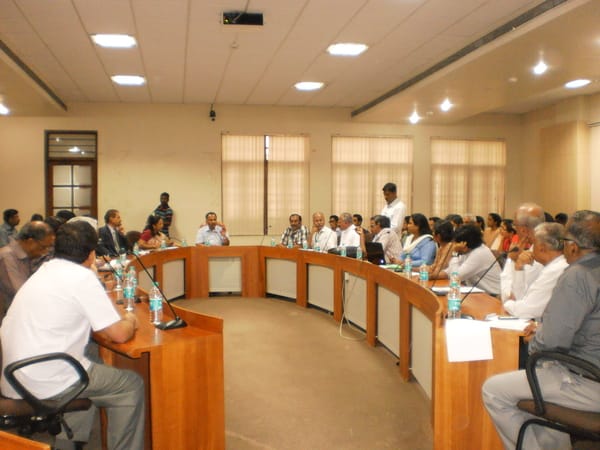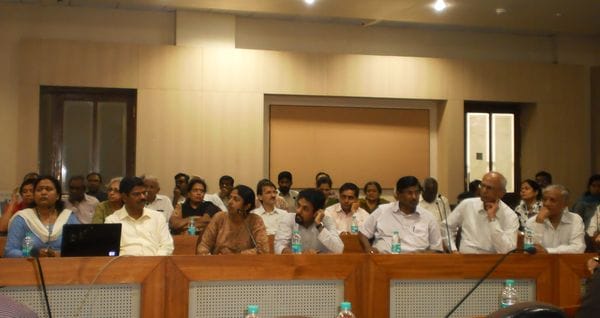After the High Court ordered the stay on signal-free corridor work in Koramangala, citizens have now formally been asked to suggest alternatives. A sub-committee, comprising six citizen representatives and a few government representatives, have been asked to submit alternate plans by August 25th.
This sub-committee was formed by, and has to report to, a government-appointed committee. According to the court order, the government-appointed committee should hear concerns of citizens and submit a report to the court on September 15th. Court will then make a final decision on the project on October 5th.
The first hearing of the government’s committee – headed by Kaushik Mukherjee, who is UDD (Urban Development Department) Additional Chief Secretary and Development Commissioner – was on August 13th.

The government-appointed committee’s hearing on August 13th. Pic: Navya P K
Other members of this committee are UDD Principal Secretary Dr Amita Prasad, ACP (Traffic) M A Saleem, and T G Sitharam, Chiarman of IISc’s CISTUP (Centre for Infrastructure, Sustainable Transport and Urban Planning). CISTUP had earlier submitted a report to BDA recommending changes in the project, clearly saying that signal-free corridors were ineffective in the long-term.
It was on the August 13th hearing that the decision was made to form a sub-committee of citizens and government officials. The committee has to submit line drawings of their alternate plans for the Sirsi-Agara corridor on August 25th, based on which government’s committee will make its decision.
The sub-committee’s citizen members include one of the PIL petitioners Nitin Seshadri and Vijayan Menon of CAF (Citizens Action Forum), along with representatives of the green NGO Hasiru Usiru, St John’s Medical Hospital (located along the project alignment), Koramangala 6th block RWA and others. UDD is yet to give the final list of selected citizen members. Government representatives are top level engineers of BBMP and BDA, Assistant Commissioner, Traffic (Adugodi), and Sitharam.
Except Koramangala 6th block RWA, all others have been opposing the project. Speaking to Citizen Matters, President of 6th block RWA, Jayaramu says, "Commuter rail and bus lanes may be long term solutions, but there is no political will to implement these. There will be relief for at least 8-10 years when the project is implemented, which is better than having nothing."
Around 50 citizens – including activists and residents of Koramangala and surrounding areas – attended the hearing on 13th. The petitioners had come armed with a detailed presentation that highlighted problems in the project approval process, and also showed alternative roads to where the project could be shifted.
Kaushik Mukherjee, Chairman of the meeting, did not entirely hear out alternative proposals, but said that he was open to those. He said that, instead of Sarjapur road, Hosur road could be widened for the corridor.

Residents at the hearing on August 13th. Pic: Navya P K
"Much traffic comes from Hosur Road side, so Hosur Road can be widened between Silk Board and Madivala checkpost. Acquire the land near Hanuman Temple on Hosur Road. Tree-cutting can be avoided as well," he said. This suggestion was greeted by applause from residents.
A main contention of Koramangala residents was that the traffic within Koramangala will be disrupted by the signal-free corridor. BDA Engineer Member Chikkarayappa said that the signal-free corridor project’s aim was to move traffic from Sirsi Circle to Agara, and not to facilitate traffic in between.
Dr Mohan from St John’s Hospital said that the project would make it difficult for patients and students to cross the road to reach the hospital. "Some 10,000 people come to the hospital daily. Ambulances come from both ends of the road. Safety of all should be assured," he said. Similar concern was voiced by the management of Sevasadan and St Francis School – that school students coming from Madivala side would not be able to cross the road; they said that the proposal to widen Hosur road should be considered.
Kathyayini Chamaraj of the NGO CIVIC said that the government-appointed committee had the power to re-consider the idea of signal-free corridor itself, instead of finding alternate locations for the corridor. Mukherjee said that this could be discussed. He said proceedings of the committee would be uploaded in the BDA website, and also that all trees that are cut would be accounted for.
Speaking to Citizen Matters, Vijayan Menon said that the outcome of the meeting was good. "We were heard and asked to come up with alternatives, unlike previous meetings on the issue. This has expanded the scope for citizens to participate in projects in the city. Our concept is that signal-free corridor benefits only car owners as opposed to pedestrians and cyclists. In a residential area with hospitals and schools, traffic should be calmed instead of aggravated further," he said.
⊕
May be, if viewed from a day-to-day life/on-going angle or perspective, the problem such as herein certainly deserves the social activists should necessarily address themselves to, to the end of a fruitful outcome, in the larger public interest .
That, however, can be no justification for not even turning the attention to, much less focusing on or giving any serious thought to the most fundamental of all, rather (grass) root problem(s) faced with by a section of the populace in our beloved Bengaluru. They are the so called ‘Apartments Community’. It needs to be realised at least at this late hour, that is an area or fact of life that has been allowed for too long (to be precise, several decades) to be continued and slept over any longer.
Pointed attention is drawn to the ongoing project work @ http://praja.in/en/blog/m…; for general guidance, see the useful posts in the form of write-ups and comments.
Also, all those amongst you people, directly concerned, ought to give, a word by reading / a mindful study , for a clear understanding of the worrisome aspects focused on in the recently published write-up on this very website, titled –
Lot More to Follow (TO BE FOLLOWED UP) >>>>
Good development. The question however is – What is the problem we are trying to solve? That question needs to be answered before anything meanigful emerges in the form of an answer. There are so many levels to this question (VISION for the city, City Master Plan (including a Transportation master Plan, Local area plan etc.). Once the goals are clear, I feel the best solution will come together easily. Do we have this homework done?